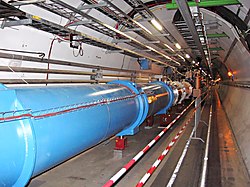Aust.-Synchrotron-Interior-Panorama,-14.06.2007
Attribution:
Das Bild ist mit 'Attribution Required' markiert, aber es wurden keine Informationen über die Attribution bereitgestellt. Vermutlich wurde bei Verwendung des MediaWiki-Templates für die CC-BY Lizenzen der Parameter für die Attribution weggelassen. Autoren und Urheber finden für die korrekte Verwendung der Templates hier ein Beispiel.
Größe:
1807 x 656 Pixel (1017852 Bytes)
Beschreibung:
A panoramic view across the interior of the Australian Synchrotron, Clayton, Victoria. The larger circular building surrounds the 216m circumference storage ring. In the middle can be seen a smaller circular building; this is the 130m circumference booster ring. The metal stairway at right leads across the storage ring down to the linac and booster ring. The hutches coming off the storage ring are the experimental endstations at the end of the beamlines. The yellow, green and red magnets on the trolley are a demonstration of the bending and focussing magnets used in the storage ring to produce the synchrotron radiation and maintain the electron beam.
Kommentar zur Lizenz:
|
This image has been released for use worldwide under the licensing specified below. If you require different licensing (e.g., for commercial publishing), or a larger or higher quality version of this image, it may be available from the author. You can contact the author by clicking here and leaving a message, or by sending me an email.
|
|
Weitere Informationen zur Lizenz des Bildes finden Sie hier. Letzte Aktualisierung: Sun, 07 Jul 2024 13:35:28 GMT
Relevante Bilder
Relevante Artikel
Synchrotron
Das Synchrotron ist ein Typ von Teilchenbeschleunigern und gehört zu den Ringbeschleunigern. Geladene Elementarteilchen oder Ionen können darin auf sehr hohe (relativistische) Geschwindigkeiten beschleunigt werden, wodurch sie sehr hohe kinetische Energien erhalten. Synchrotrone wurden entwickelt, um über die mit Zyklotronen erreichbaren Energien hinauszukommen.
.. weiterlesen



